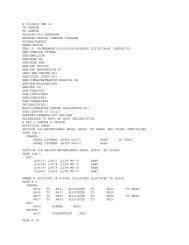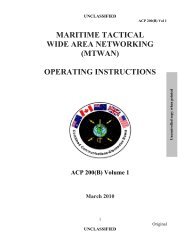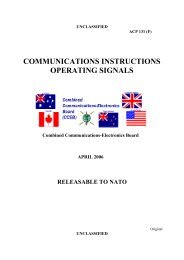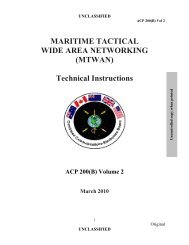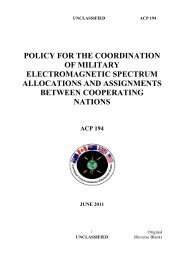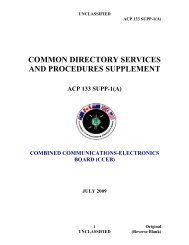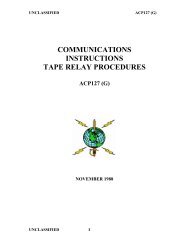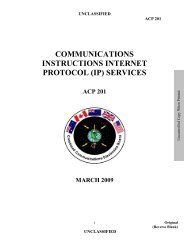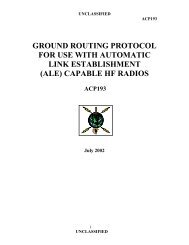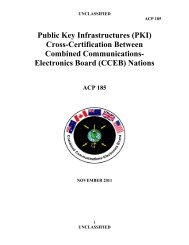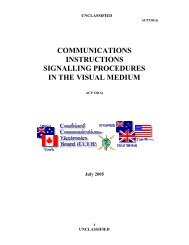communication instructions radio telegraph procedure
communication instructions radio telegraph procedure
communication instructions radio telegraph procedure
You also want an ePaper? Increase the reach of your titles
YUMPU automatically turns print PDFs into web optimized ePapers that Google loves.
UNCLASSIFIED ACP124 (D)<br />
215. DUAL PRECEDENCE<br />
Multiple address messages having both action and information addressees may either be assigned<br />
a single precedence, in which case it indicates the precedence for all addressees, or they may be assigned<br />
two precedences, one precedence for all action addressees and a lower precedence for all information<br />
addressees. The <strong>procedure</strong> for indicating dual precedence in the heading of plaindress and codress<br />
messages is as follows:<br />
a. Plaindress. Both precedence prosigns, separated by the separative sign, will appear as<br />
the first element of the preamble; the higher precedence will appear first.<br />
UNCLASSIFIED 2-10<br />
EXAMPLE: (Immediate to action addressees and Routine to<br />
information addressees.)<br />
NPQR DE GABB<br />
-O-R-061217Z JUL 83<br />
-FM GABB<br />
- TO NPQR<br />
- INFO M9VO<br />
NPQT<br />
Z3P0<br />
__<br />
BT<br />
b. Codress. Both precedence prosigns, separated by the separative sign, will appear as the<br />
first element of the preamble; the higher precedence will appear first. However, when a message is<br />
routed to a crypto guard which serves all the addressees, the higher precedence prosign only will be<br />
included in the preamble. The lower precedence will be included in the encrypted text in the form "…<br />
(lower precedence) for information addressees".<br />
c. Codress Transmission Instructions. A separate heading will be prepared for each<br />
transmission of a dual precedence codress message in accordance with subparagraph 210a. Any<br />
station(s) or addressee(s) included in the heading of the message who is/are to receive the message at the<br />
lower precedence (i.e. information addressees or stations having to serve information addressees) will be<br />
indicated in the transmission <strong>instructions</strong> by means of an operating signal ZOT "Transmit or handle this<br />
message at the lower precedence to the station(s)/address designator(s) which follow"), followed by the<br />
identification of the station(s)/addressee(s) concerned. The absence of the operating signal automatically<br />
indicates that the message is to be handled at the higher precedence by all stations. If T <strong>instructions</strong> are<br />
specifically included and the transmission <strong>instructions</strong> become long or complicated, those stations for<br />
whom the message is intended at the lower precedence may be collated and shown together after<br />
operating signal ZOT. ZOT will then be inserted after the last T addressee designation.<br />
EXAMPLE 1: (GABB directs NPQR to transmit the message at the lower<br />
precedence to C2S6.)<br />
NPQR DE GABB<br />
-ZOT C2S6<br />
- P - R - 141816Z JUL 83<br />
GR71<br />
BT etc.



